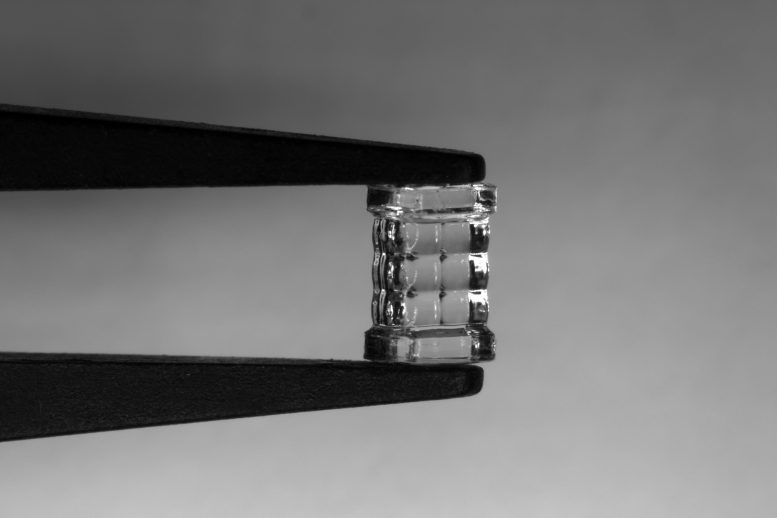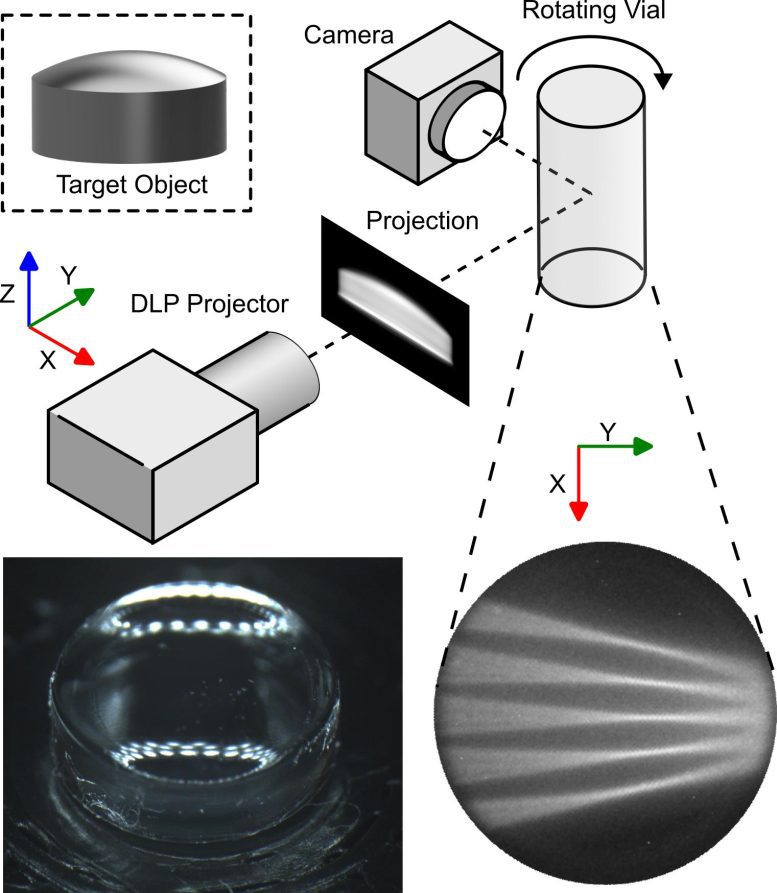
Researchers have come up with a new 3D printing technique called blurred tomography, which can quickly make microlenses with commercial-level optical quality. They demonstrated this by printing a microlens array, as shown in a photo with tweezers. Credit: Daniel Webber, National Research Council of Canada
A new 3D printing method has been developed to make commercial grade microlenses with smooth surfaces, advancing optical device design.
Canada-based researchers have come up with a new 3D printing method called blurred tomography, which can rapidly produce microlenses with commercial-level optical quality. This could make it easier and faster to design and produce various optical devices.
Daniel Webber from the National Research Council of Canada stated that they intentionally introduced optical blurring to the light beams used in this 3D printing method to produce precise optical components. This allows for the creation of optically smooth surfaces.
In OpticaIn a journal for impactful research, these researchers demonstrate the new method by using it to create a millimeter-sized plano-convex optical lens with imaging performance similar to a commercially available glass lens. They also show that the method can produce optical components ready for use in just 30 minutes.
Webber stated, “We expect this method to be useful for cost-effective and fast prototyping of optical components due to the affordability of the tomographic 3D printer and materials used. Additionally, the naturally freeform nature of tomographic 3D printing could simplify designs by replacing multiple standard optics with printed optics of complex shapes.”

The new technique uses a custom projection lens to blur the laser beams used for solidifying a light-sensitive resin. This results in an optically smooth surface, allowing printing of commercial quality lenses like the one shown in the bottom left. Credit: Daniel Webber, National Research Council of Canada
Smoothing Out the Edges
Tomographic volumetric additive manufacturing is a relatively new approach that uses projected light to solidify a light-sensitive resin in specific areas, allowing an entire part to be printed at once without support structures. However, existing tomographic methods cannot directly print imaging-quality lenses because the pencil-like beams used create striations and small ridges. Post-processing steps can be used to create smooth surfaces, but these add time and complexity, negating the rapid prototyping advantage of tomographic printing.
Dr. Webber mentioned, “Manufacturing optical components is expensive due to the strict technical requirements for a functioning lens, as well as the complex and time-consuming manufacturing process. Blurred tomography can be used to create freeform designs in a cost-effective manner. As the technology advances, it could enable much quicker prototyping for new optical devices, benefiting commercial manufacturers and DIY inventors alike.”
Creating Small Lenses
To test the new technique, the researchers initially made a basic curved lens and demonstrated that it had an imaging quality similar to a commercial glass lens with the same physical size. It also had a tiny form error, extremely smooth surface, and a point spread function similar to the glass lens.
They also created a grid of small lenses using blurred tomography and compared it to a grid made with traditional tomographic 3D printing. They discovered that it was not possible to capture an image of a business card with the grid made conventionally because of significant surface roughness, but it could be achieved with the grid made using blurred tomography. Moreover, the researchers showed how to add a ball lens onto an optical fiber, which was previously only possible using a manufacturing technique called two-photon polymerization.
They are currently working on improving the precision of the components by refining the light patterning method and integrating material parameters into the printing process. They also aim to automate the printing process to make the system strong enough for commercial use.
“Tomographic 3D printing is a rapidly evolving field that is being used in various applications,” said Webber. “Here, we capitalize on the inherent advantages of this 3D printing method to create millimeter-sized optical components. In doing so, we have expanded the range of optical manufacturing techniques with a quick and cost-effective alternative that could potentially impact future technologies.”
Reference: “Micro-optics Fabrication using Blurred Tomography” by D. Webber, Y. Zhang, K. L. Sampson, M. Picard, T. Lacelle, C. Paquet, J. Boisvert, A. Orth, 9 May 2024, Optica.
DOI: 10.1364/OPTICA.519278.



